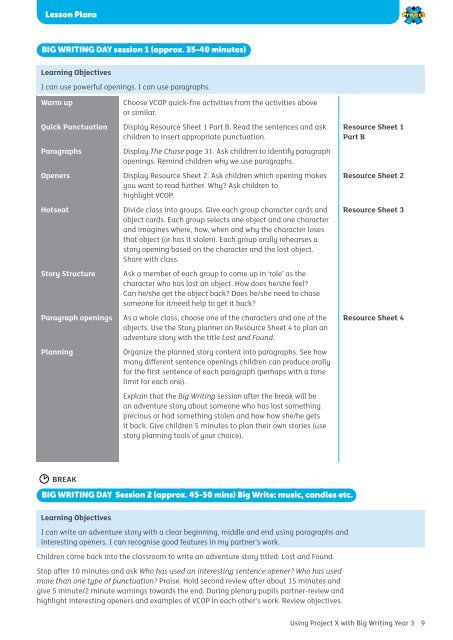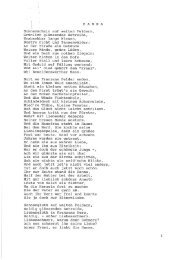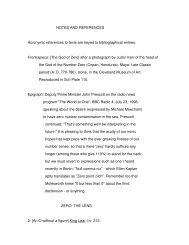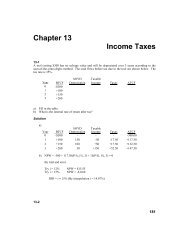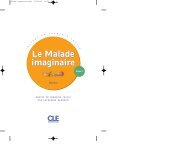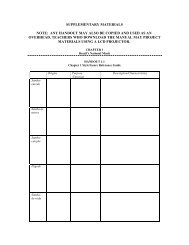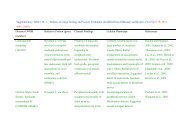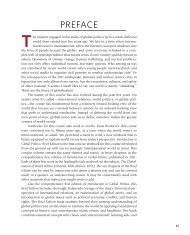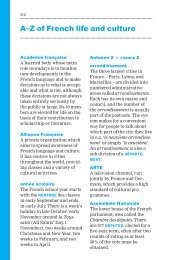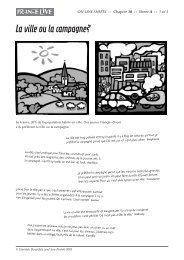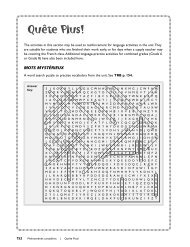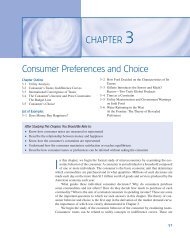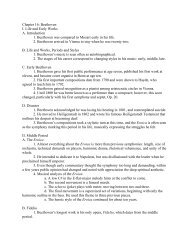Big Writing - Oxford University Press
Big Writing - Oxford University Press
Big Writing - Oxford University Press
You also want an ePaper? Increase the reach of your titles
YUMPU automatically turns print PDFs into web optimized ePapers that Google loves.
Lesson Plans<br />
BIG WRITING DAY session 1 (approx. 35-40 minutes)<br />
Learning Objectives<br />
I can use powerful openings. I can use paragraphs.<br />
Warm up<br />
Quick Punctuation<br />
Paragraphs<br />
Openers<br />
Hotseat<br />
Story Structure<br />
Paragraph openings<br />
Planning<br />
BREAK<br />
Choose VCOP quick-fire activities from the activities above<br />
or similar.<br />
Display Resource Sheet 1 Part B. Read the sentences and ask<br />
children to insert appropriate punctuation.<br />
Display The Chase page 31. Ask children to identify paragraph<br />
openings. Remind children why we use paragraphs.<br />
Display Resource Sheet 2. Ask children which opening makes<br />
you want to read further. Why? Ask children to<br />
highlight VCOP.<br />
Divide class into groups. Give each group character cards and<br />
object cards. Each group selects one object and one character<br />
and imagines where, how, when and why the character loses<br />
that object (or has it stolen). Each group orally rehearses a<br />
story opening based on the character and the lost object.<br />
Share with class.<br />
Ask a member of each group to come up in ‘role’ as the<br />
character who has lost an object. How does he/she feel?<br />
Can he/she get the object back? Does he/she need to chase<br />
someone for it/need help to get it back?<br />
As a whole class, choose one of the characters and one of the<br />
objects. Use the Story planner on Resource Sheet 4 to plan an<br />
adventure story with the title Lost and Found.<br />
Organize the planned story content into paragraphs. See how<br />
many different sentence openings children can produce orally<br />
for the first sentence of each paragraph (perhaps with a time<br />
limit for each one).<br />
Explain that the <strong>Big</strong> <strong>Writing</strong> session after the break will be<br />
an adventure story about someone who has lost something<br />
precious or had something stolen and how how she/he gets<br />
it back. Give children 5 minutes to plan their own stories (use<br />
story planning tools of your choice).<br />
BIG WRITING DAY Session 2 (approx. 45-50 mins) <strong>Big</strong> Write: music, candles etc.<br />
Learning Objectives<br />
I can write an adventure story with a clear beginning, middle and end using paragraphs and<br />
interesting openers. I can recognise good features in my partner’s work.<br />
Children come back into the classroom to write an adventure story titled: Lost and Found.<br />
Stop after 10 minutes and ask Who has used an interesting sentence opener? Who has used<br />
more than one type of punctuation? Praise. Hold second review after about 15 minutes and<br />
give 5 minute/2 minute warnings towards the end. During plenary pupils partner-review and<br />
highlight interesting openers and examples of VCOP in each other’s work. Review objectives.<br />
Resource Sheet 1<br />
Part B<br />
Resource Sheet 2<br />
Resource Sheet 3<br />
Resource Sheet 4<br />
Using Project X with <strong>Big</strong> <strong>Writing</strong> Year 3 9


